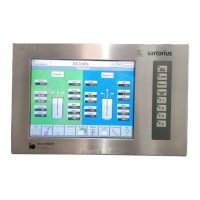Operators Handbook DCU3 – System
6., Main function „Control Loops“
BAEDCU3 - Rev. 4.6 - 0504 6 - 27
6.17 Level Controller
6.17.1 Control Principles
The level control function of the DCU3 - system allows for a simple level control by means of height-
adjustable conductive level probes. The probe will be connected to the „Level“ measurement amplifier
of the DCU3 system whose the limit output signal acts as input on the level controller. The limit value
signal is active as long as the probe is in contact with liquid.
The sensitivity of the amplifier can be adjusted to different conductivities of the culture liquid to avoid
unintended controller activities due to splashing, for instance. An adjustable delay time for controlled
pumps assures stable operation of the level controller.
The level control function of the DCU3 - system offers several control strategies that can be selected
the operator according to the requirements of the process.
6.17.1.1 Single Sensor Control with Harvest Pump Control
This control method enables a feed pump to continuously supply a substrate to the vessel. When the
culture medium exceeds the max. filling volume (as adjusted with the insertion height of the sensor),
the sensor has contact with the medium and the limit signal is released. The level control switches the
harvest pump to either „on“ or „off“ state, i.e. it activates the pump as long as the limit signal is „on“.
6.17.1.2 Single Sensor Control with Feed Pump Control
When this control method is applied, a harvest pump can be run continuously at a fixed pump rate,
removing medium from the vessel. Hence the medium level in the vessel decreases. When the sensor
has no longer contact with the medium, the level control function activates a feed pump to supply fresh
medium into the vessel. The feed pump is operated in „on/off“ mode.

